Care of and Feeding Doves in an Aviary
Creating an aviary
Originally published 3/17/12 & updated 3/5/21
Rescued domestic pigeons are smart, gentle, gorgeous, charming birds that mate for life and coo softly to each other. They are bred and used as if disposable for business and hobbies (squab, "dove release", bait birds, racing, show). Many die as a result but those lucky enough to be rescued alive need homes and make amazing companions. They are unreleasable- domestic birds unable to find food or fly well enough to evade predators. They don't survive in the wild and need safe, non-exploitive homes. There is no "free" for domestic pigeons. Keeping them in an aviary is not cruel, it is life saving. (And the same for domestic doves too.)
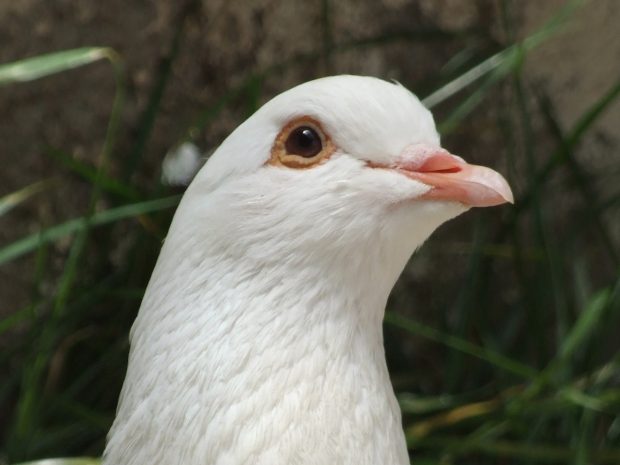
Sick and emaciated, King pigeon June Bug faced euthanasia at the animal shelter but with rescue and care, made a full recovery and was adopted into a wonderful home.
I met a King pigeon scheduled to be euthanized (for lack of an adopter) in an animal shelter in 2007 and after finding her a home, created MickaCoo Pigeon & Dove Rescue which grew into Palomacy Pigeon & Dove Adoptions. Since then, in Northern California, we've placed more than 1,000 with wonderful adopters and helped countless others all over the country and beyond but even so we're always full up with birds in foster care and with a waiting list of more needing help. We need more adopters! It is easy to create a beautiful, charming and life-saving aviary for these birds. We would love to help you to provide a home for these rescued innocents.
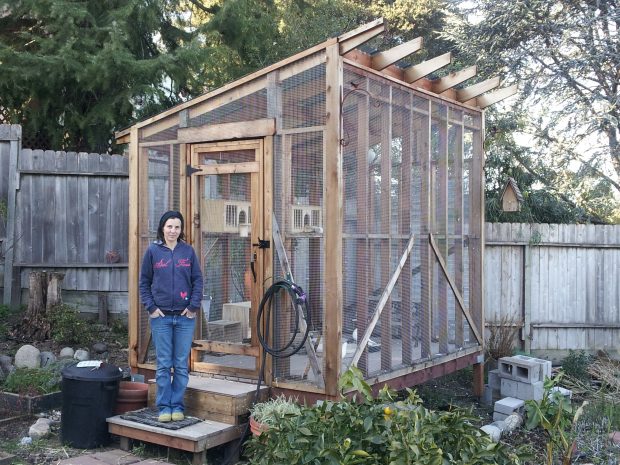
Beautiful and easy aviary, life-saving for 6-8 birds
Here is the most important information:
When building an aviary for pigeons or doves, there are a few basic principles that are essential.
- The aviary must be built sturdy to protect against predators & rodents (no matter where you live nor what deterrents you have).
- The entire enclosure- the bottom, sides & top – must be .5″ or .25″ hardware cloth that is connected to 'seal the envelope' with no gaps more than .5″.
- Flooring, siding, roofing goes on over the mesh.
- Never use chicken wire (nor bird netting) as it is a death trap for the birds confined within it.
- Build it as big as you can.
- Half should be sheltered (roofing & siding) & half open for light & air.
- Locate it in a sunny spot (shade is easy to create) where you can see & enjoy the birds.
- Make sure all doors & latches are racoon-proof.
See our panel aviaries for a great design, check out How to DIY Make a Safe, Easy Aviary (with a kennel & hardware cloth) & read on for lots more helpful information.
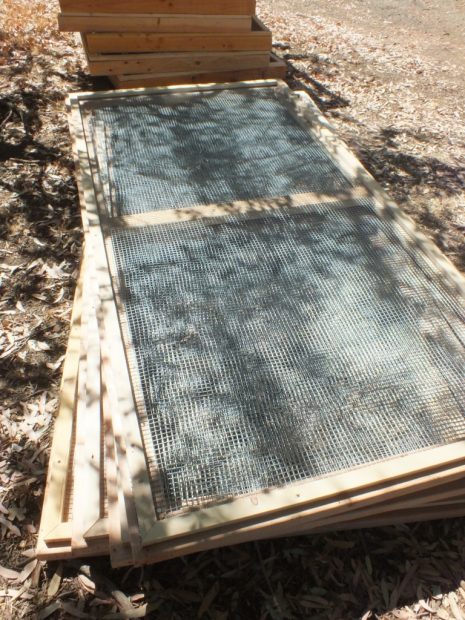
We affix .5″ or .25″ mesh to 4 x 8′ panels built with 2 x4s & then bolt them together to create the floor, walls & ceiling
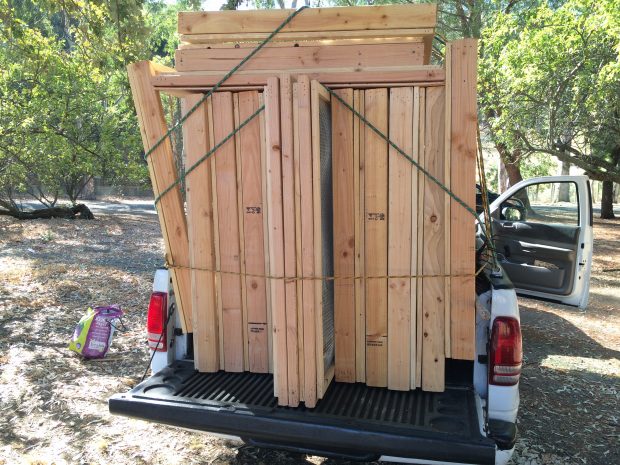
Pre-built panels are easy to build, efficient, affordable, transportable, easy to assemble & easy to disassemble & relocate if needed
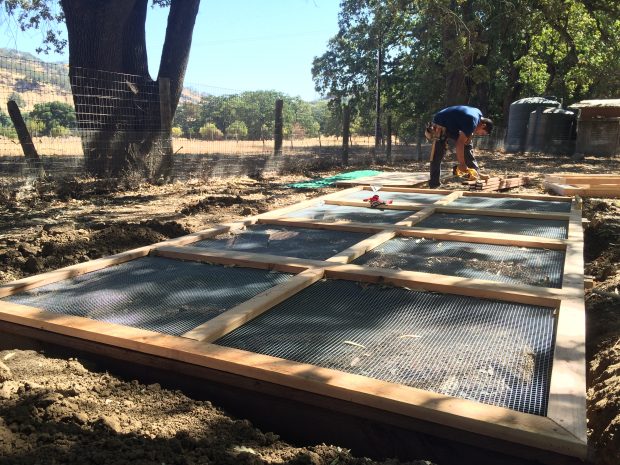
The predator & rodent-proof floor for this 16′ long & 8′ wide aviary is built from four 4 x 8 meshed panels bolted together
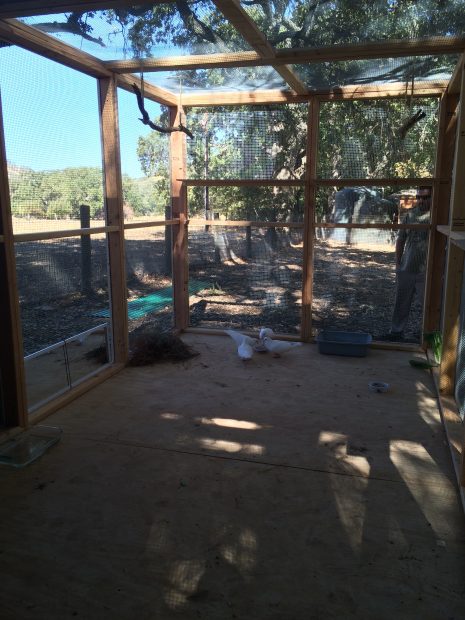
The meshed bottom is covered with a smooth pigeon-friendly floor like plywood, cement pavers, Trex or vinyl
See how this aviary was built at Life-saving, Game-changing Partnership for King Pigeons.
Domestic pigeons are calm and good natured and they excel at the leisure arts. They can live very happily year-round in an outdoor aviary (no heating or cooling required in most locales). It needs to be predator-proof (sturdy and securely built), rodent-proof (use mesh with openings no more than half an inch), and include a sheltered corner and back area that will provide enough deep shade for all in the hottest weather and protection from blowing rain in the winter. They require about 20 minutes of daily care with a weekly aviary cleaning (about an hour). They are quiet and peaceful and, with time and attention, most can be hand-tamed.
It's easy to create a charming, attractive and safe aviary for rescued unreleasable pigeons. (Please don't make wild birds captive. There are so many who can't live free and need homes!)
An aviary for rescued pigeons or doves is easy to design (Illustration courtesy of Julia Green)
Size
Build it as large as your space and budget allow. No one has ever wished for a smaller aviary. Because domestic pigeons can't be safely free-flown, they will spend all their time inside the aviary. Space is one of the greatest gifts you can give to a captive bird. For your own convenience, you'll want something big enough to walk into (easier to maintain) but, if you really want to enjoy your birds, build it large enough so that you can sit down on a chair or a bench inside the aviary and be a member of the flock. The minimum size that I recommend is 7′ long by 4′ wide by 6′ high for two or four pigeons (or eight doves). Note: a single pigeon or dove needs to live inside with you. It's way too stressful and lonesome for one bird to live alone outside. An aviary 8′ long by 8′ wide by 6'+ tall or more will house up to 10 pigeons and you and your birds will have a lot more fun. (Learn more about pigeons as pets here.) We're often asked about using an outdoor cage or a "pigeon coop" but neither are recommended. Cages are too small for a bird to spend their whole life inside and so need to be located indoors where the bird(s) can have safe daily out of cage time in your home. (If the enclosure is too small for you to get inside and move around, it's a cage- not an aviary- and too small for birds to live in outside. Learn important info about cages here.) "Pigeon coops" are tiny, cramped and awful. They are designed to be easy and cheap for people, not to be right for pigeons. The birds have no space to move nor to live a life and those who don't know better think letting the pigeons out to free fly makes up for it. It doesn't. And free flying is deadly for domestic pigeons. There is no domestic sky.
Never say you don't have room for an aviary
This covered patio was modified to be a 10′ x 13′ pigeon aviary.
This big, beautiful aviary houses 24 rescued pigeons
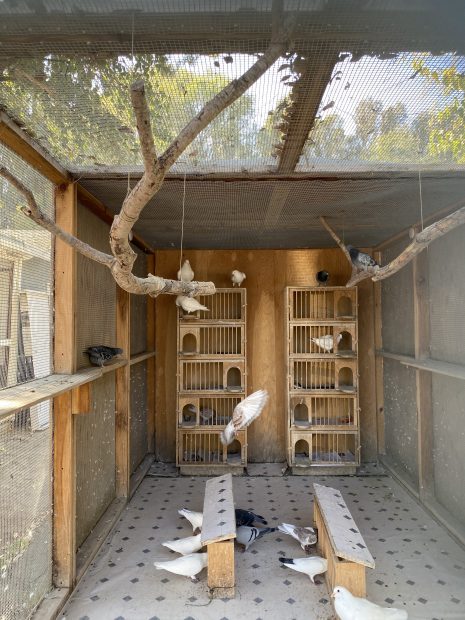
This 16 x 8 x 8 panel aviary for rescued pigeons is at Jameson's Animal Rescue Ranch in Napa (click photo to see story)
Design
Horizontal space is most important. Even birds that can't fly well enough to survive in the wild like to stretch their wings and fly a bit so design your aviary to be as long as possible. I recommend a minimum length of 7′ (longer is better) and rectangular shaped-aviaries offer maximum opportunity to fly a few wingbeats. Round or hexagonal shapes, while pleasing to look at, have to be very large to offer the same opportunity. Pigeons are ground feeders and will forage (and strut and flirt and bathe and socialize) on the ground but they also will fly to and perch in the middle and upper reaches. I recommend a peaked or sloped roof to prevent rain from pooling on top and because the birds will enjoy roosting up in the "attic". Leave at least some of the roof as mesh rather than solid to let in sunshine, rain, moonlight and air circulation.
An aviary can be built by a do-it-yourselfer or with the help of a hired handy person
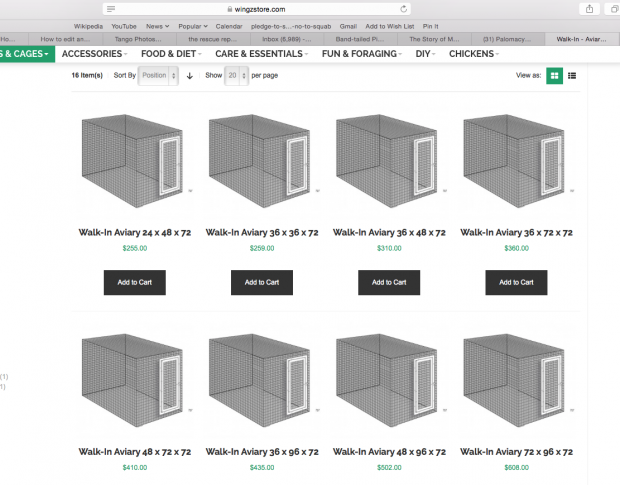
Most pre-made aviaries & catios aren't safe for your pigeons (poorly designed & too lightly built) but the .5″ gap Wingzstore aviaries are (Click photo for www.Wingzstore.com)
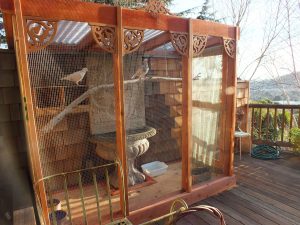
A clever lost racing pigeon, Polka Dot, inspired this lovely aviary (big enough for 4 birds)
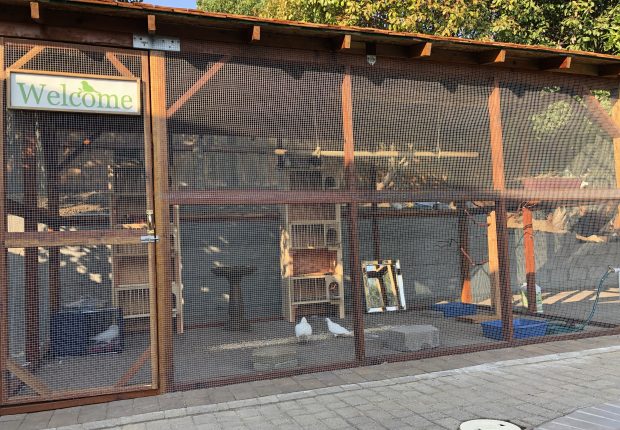
A brilliant self-rescuing pigeon named Glory inspired her people to build this big, beautiful aviary for her & lots of rescued friends. (Click photo to see her story)
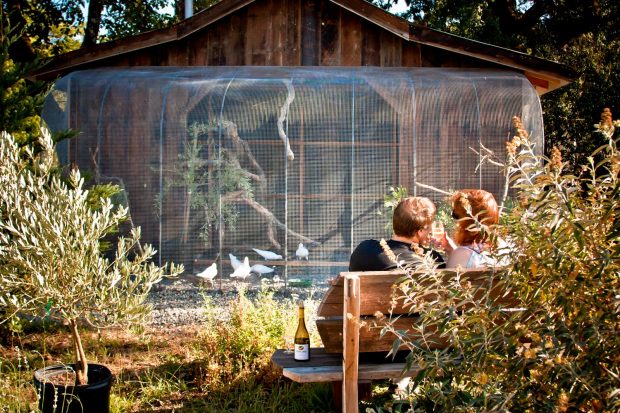
Aviaries are wonderful enhancements to wineries like this one at Terra Savia- easy to maintain & much enjoyed by guests (Click photo to see the story)
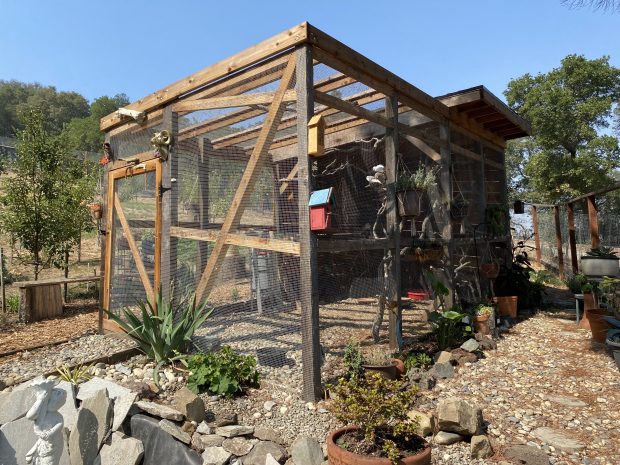
San Damiano Retreat in Danville built this big, beautiful aviary for rescued pigeons in the spirit of St. Francis (Click for story)
Location
When locating your aviary, I suggest choosing the site that offers you the best view of it while also balancing the needs of the birds and your neighbors too. Pigeons are quiet but they do coo and so you'll want to consider the sounds they make when locating the aviary. Pigeons have poor low-light vision so a bright location is preferable. They enjoy sunshine as well as rain and so I like aviaries that get both. (It is important that their nest boxes stay dry.)
Designed to share a window for maximum fun
People lose themselves while enjoying their birds
Rescued pigeon Gem inspired Shae to build this aviary
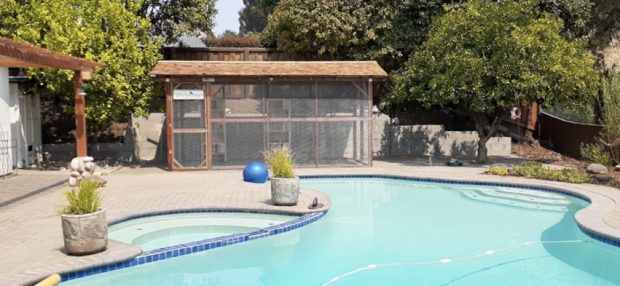
An aviary, built for rescued pigeons, is a wonderful, engaging addition to any setting
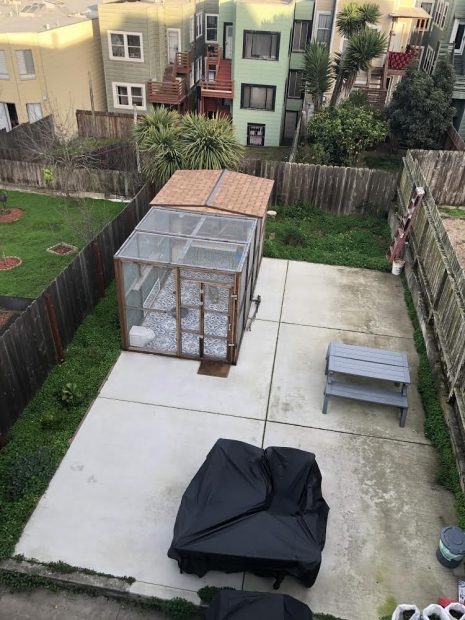
Adopters commissioned this beautiful aviary for their backyard
Foundation/Ground Cover
An aviary can be built onto a cement pad, cement pavers, a wooden floor lined with hardware cloth (to keep rodents from chewing through the wood) or on earth. It should be easy to keep clean, provide good drainage, and protect against rodents and predators that will try to dig or chew their way in. Unless the floor is cement, the entire bottom of the aviary must be lined with hardware mesh (half inch openings or less) to keep rodents and predators out. The mesh should be covered by wood, cement pavers, tile or vinyl as standing on wire is harmful to their feet. My backyard aviary is a converted patio and so the bottom is cement. That's fine for the birds but it would be easier for me to maintain if it was smooth and sloped for drainage. With cement (or wood or tile), the bottom needs a daily poop scraping.
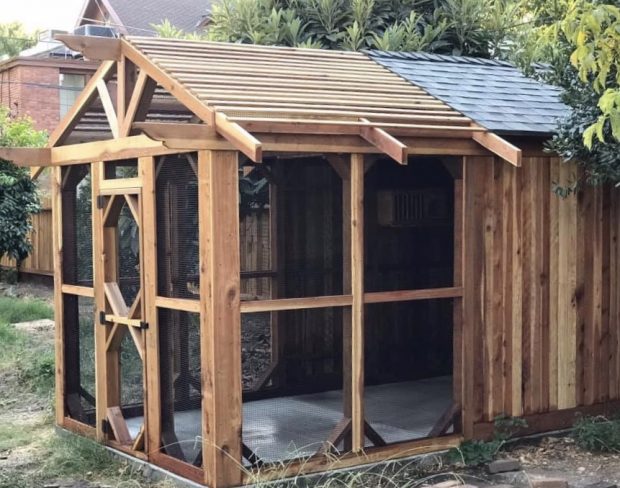
Cynthia & daughter Maryam designed & built this beautiful aviary with a poured cement floor that includes a drain
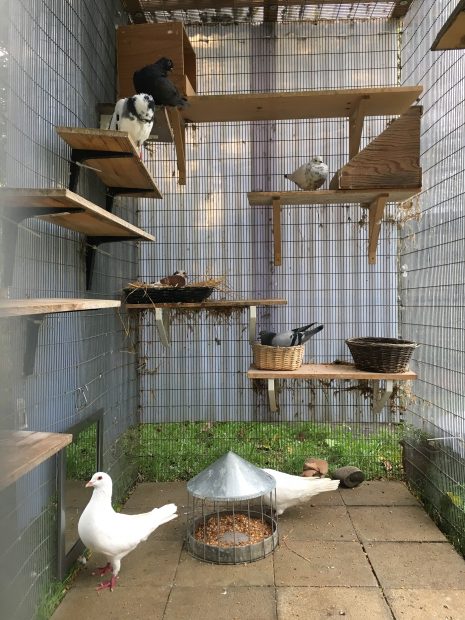
Cement pavers like these, placed over rodent-proof mesh, make a comfortable, enduring & easy to clean aviary floor
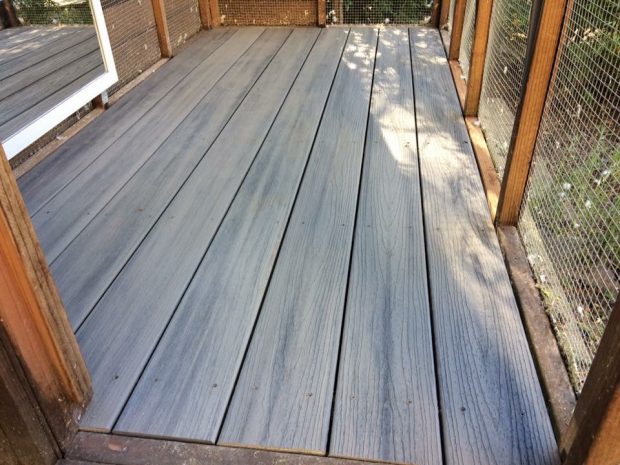
Composite decking like Trex, underlined by rodent-proof hardware mesh, makes a great aviary floor
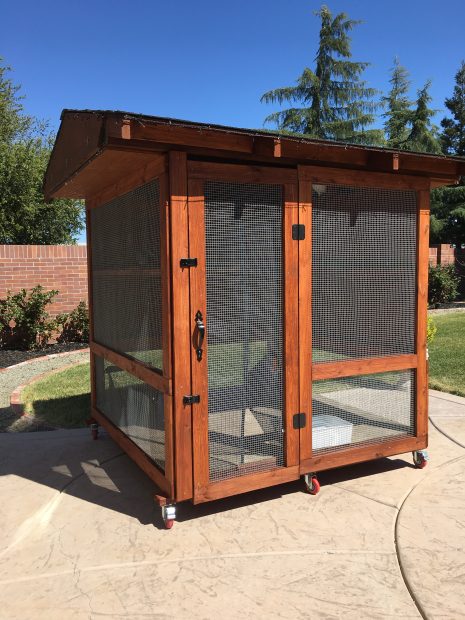
This aviary, built on wheels as to be easily moved around the patio, has a mesh floor overlayed with vinyl
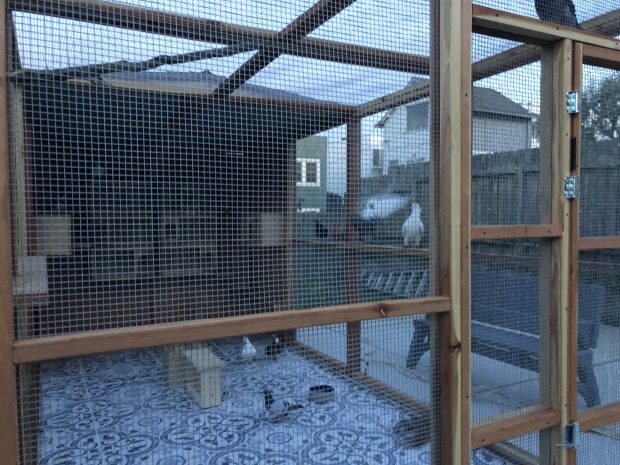
This beautiful aviary has a floor of meshed panels overlayed with tile
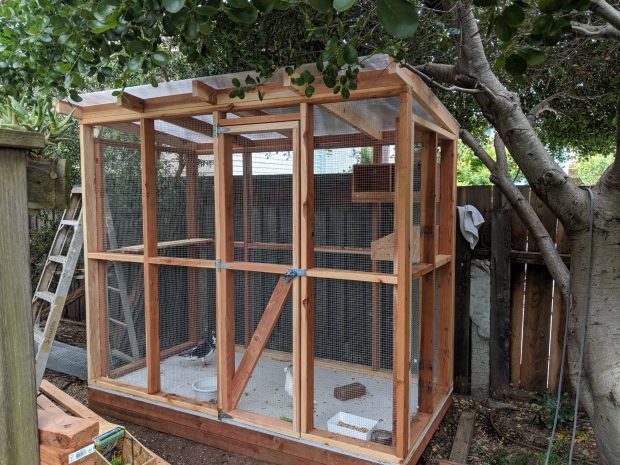
To be safe, aviaries have to enclosed with predator & rodent-proof hardware cloth ALL THE WAY AROUND- under the floor, under the roofing & siding
(Note: We now recommend against drain rock as it proved problematic over time, especially as an amplifier of roundworm risks. Sorry!)
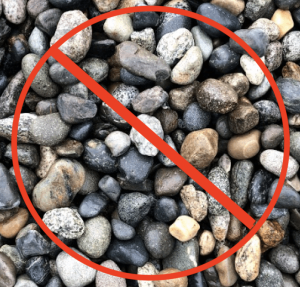
Palomacy no longer recommends drain rock (ironically, traps water & amplifies roundworm risk)!
Construction
An aviary must be rodent and predator-proof and even the most urban or suburban of neighborhoods have at minimum cats, birds of prey, rats and raccoons that will have to be kept out. (Some environments have lots more wildlife to guard against.) The aviary needs to be built sturdily. Raccoons are incredibly strong and tenacious and, if they locate a weak spot in the design, they will work on it night after night until they get in. On the other hand, if the aviary is well-built, predators will stop testing it and leave your birds to live in peace. And your aviary needs to be sealed completely with wildlife-proof mesh with openings .5″ or smaller. The size (and strength) of the mesh is important. If the openings are bigger, you'll attract mice and put your birds within claw's reach of all sorts of animals. Online searches of aviaries will show pictures of aviaries made with chickenwire or chain link but they don't show the carnage that predators cause by reaching through those too-big openings and tearing birds apart while still "safely" inside. Also, mesh openings bigger than half an inch is inviting every mouse in the world (plus any petite rats) to move in make themselves at home forever. It's much easier to build the aviary rodent and predator-proof than it is to go back and patch one that wasn't.
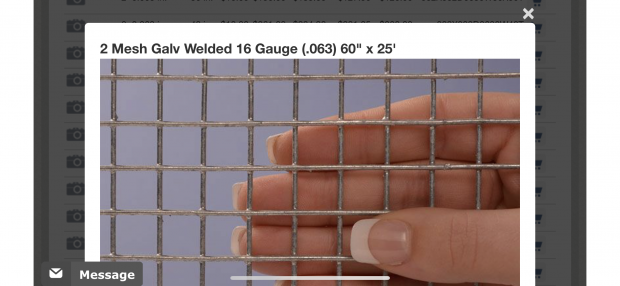
Only use mesh (hardware cloth) with openings half an inch or smaller! (This is .5″)
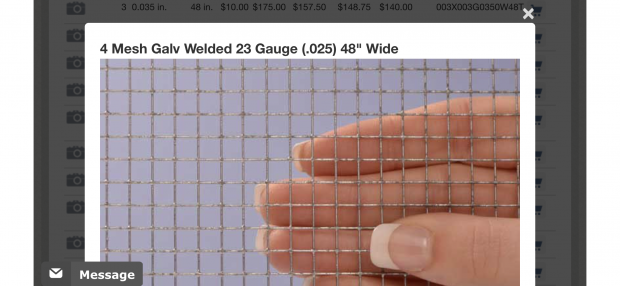
We're recommending .25″ like this more & more. Keeps even the littlest mice out.
Always secure every lock and latch. Raccoons are very clever and deadly
Weather & Shelter
I live in San Francisco and Palomacy adopters and volunteers have aviaries throughout the Bay Area. Our weather is mild. The pigeons' aviaries need to provide a sheltered corner that offers access to deep shade (to guard against overheating) and protection from driving winter rains. They love the rain and not all of it needs to be kept out but their nest boxes must stay dry. Depending on where you live, you may need to provide extra protection from weather conditions. Rescued pigeons, provided they have appropriate shelter and food, thrive in aviaries across all climates throughout the United States and the world. (They live everywhere except Antarctica.)
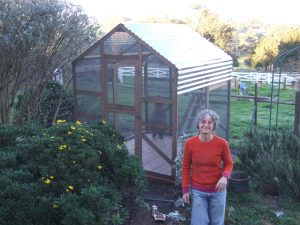
Dawnelle's aviary houses 4 pigeons in Petaluma
Cheryl's aviary keeps her pet and foster pigeons happy & comfortable
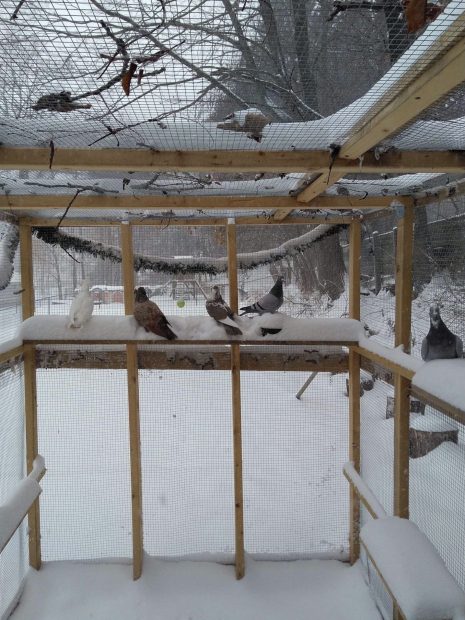
In NY, Gwenn's rescued pigeons love playing in the snow despite having a cozy, enclosed shelter
Nest Boxes
Your pigeons need nest boxes. These are for nesting and being cozy rather than nesting to breed babies. Palomacy opposes breeding because there are already so many "surplus" pigeons literally dying for lack of a home every day. Nest boxes are provided because pigeons are cavity nesters and they love and need a cubby-hole type nest area. A nest box can be as simple as a basket or wooden box. Nest boxes can be purchased ready made or built along with the aviary.
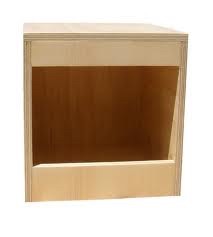
At minimum, each pair of pigeons needs one nest box that is 12″ deep x 12″ wide x 12″ tall (chicken nest boxes like this one work great)
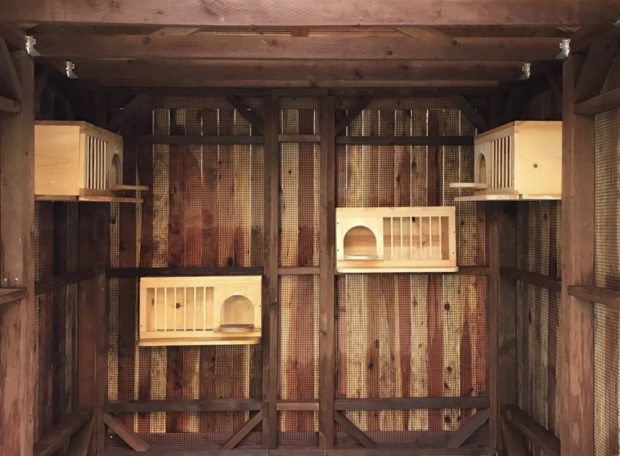
Nest boxes can be bigger & fancier like these. Spacing them out increases harmony & reduces conflicts with neighbors
When pigeons become mature (between 4 and 6 months of age), they court, choose a mate and select a nest box in which they'll build a loosely constructed nest. The hen will lay a pair of eggs and the couple will take turns sitting on them. We provide fake eggs which are substituted for the real eggs (for pigeon birth control).
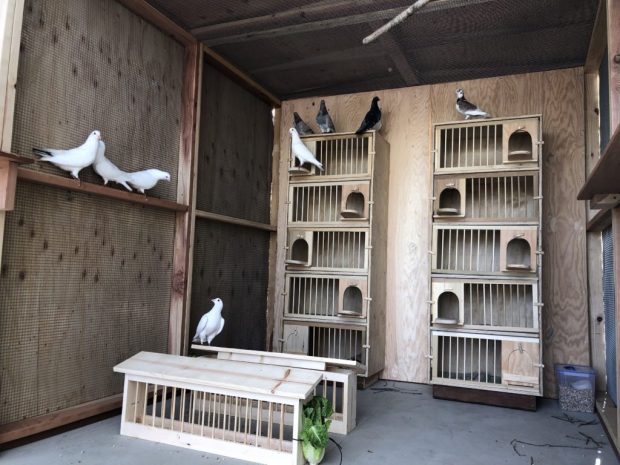
Nest box towers like these are easy to construct & the fancy fronts can be ordered online & added. Pigeons bicker less with up & down neighbors so Palomacy recommends vertical configurations
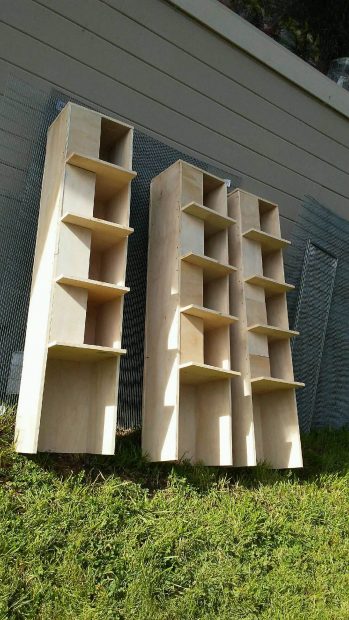
These home meade nest box towers include pigeon-appreciated features like the patio/landing strip & the privacy guard shielding half the box. Each tower of 4 boxes is enough for 8 pigeons
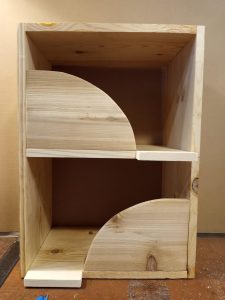
Love this design! Perfect to help pigeon neighbors get along. (They would like a bigger patio/landing strip though.)
Perches
Pigeons don't climb like parrots do (and they're fine with galvanized wire). They need open space to jump or fly up and down from perches. They also really enjoy shelves to lounge on. Situating perches near the aviary's mesh walls will give the birds an easy view out and allow you a close look at their beauty and personality. I recommend using natural branches (approximately 1-2″ diameter) because their size usually varies from tip to trunk and it is good for bird to be able to vary the grip of their feet.
Food & Water
Pigeons love water and will need fresh, clean water every day for drinking and for bathing. I use clear, plastic containers because I love to watch their happy pink bathing feet dancing in the water but you can use ceramic casserole dishes or large plant saucers. The water should be between 2-4″ deep and changed daily. It's best to provide two water sources and I recommend getting duplicates of whatever containers you use so that one set can be cleaned and dried while the other is being used. Pigeons are ground foragers and their food dishes should be on the ground. I recommend one dinner-plate size dish (with ~1 cup of pigeon feed) for every four pigeons each day. Feed can be purchased at feed stores and is a mix of different types of peas, corn, oats, safflower, milo and other grains. It can be stored in a rodent-proof, moisture-proof container. An extra treat of a planter of lettuces or parsley or dandelion greens or spinach or wheat grass will be appreciated. Whatever type container you use, make it something non-toxic.
Mirrors
Pigeons have been proven to self-recognize in mirrors (along with elephants, dolphins and chimpanzees) and they enjoy them very much. I think they use them like we use TV. We know TV isn't real but we still get emotionally engaged in what we see and are entertained by the experience. I recommend securing a full-length mirror horizontal to the ground and enjoying the show.
Maintenance
The birds need clean food and water dishes every day. Once a week, a poop scrape of flat surfaces and hose-down will keep your aviary clean and your birds happy. I use a paint scraper and a dust bin. (The poop is world class for composting.) Keeping your aviary uncrowded will help keep it clean and healthy too.
Miscellaneous
King pigeons are generally calm and easy going. You don't need a double-door to keep them from flying out (but do be conscientious about keeping the aviary door closed). You can mow your lawn, blow your leaves, play with your dog and let your cats hang out in the yard- all without frightening king pigeons. They understand the difference between inside and out and they don't worry about what goes on outside the aviary. You can also be creative. It's easy to repurpose a shed or play gym into a wonderful aviary. And, if you'd rather rescue doves or homers or rollers, you can still use this same design to create your aviary. Doves, homers and rollers are smaller and so you can scale down the size of perches and nest boxes but they're better and more active flyers so they'll appreciate the fly space. And you don't need a "trap" (the door that free-flying pigeons use to exit and enter a pigeon loft) because rescued pigeons and doves can't be safely free-flown. That's why they need you to create them a lovely, charming and life-saving aviary.
Recommended Links & Resources
Ask Greg
Ask Josette
Palomacy Help Group
Ask Elizabeth
Nyla Copp, Aviary Builder
Wes Askins, BestCoops
More to come . . .
Until there are homes for all, don't buy, don't breed — adopt!
Source: https://www.pigeonrescue.org/birds/creating-an-aviary/
0 Response to "Care of and Feeding Doves in an Aviary"
Post a Comment